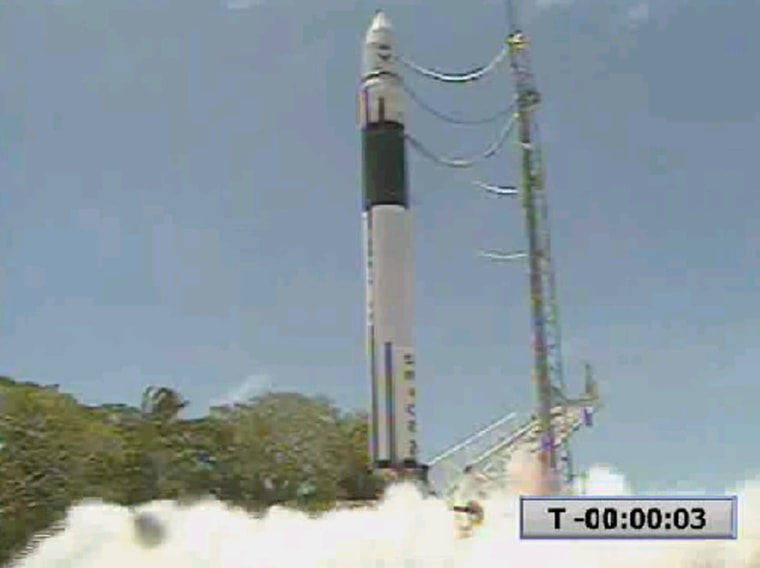For the second day in a row, SpaceX on Tuesday aborted the launch of its low-cost Falcon 1 rocket — this time just as it was firing up to leave the launch pad.
The launch attempt was aborted because the pressure inside the rocket engine's combustion chamber was 0.2 percent below what was required, said Gwynne Shotwell, the company's vice president for business development.
She said the launch team was preparing for yet another attempt on Tuesday. "We're going to try again," she told reporters.
The $7 million mission, funded by the Pentagon’s Defense Advanced Research Projects Agency, is aimed at demonstrating Falcon 1’s suitability for orbital launches to come. The two-stage, semi-reusable rocket carries a 100-pound (50-kilogram) experimental payload with monitoring equipment developed by NASA.
Tuesday's countdown went all the way to zero, and a Webcast showed the Falcon 1's engine firing on the pad. But even as smoke and vapor surrounded the rocket, the launch team announced that the liftoff was aborted. After the smoke cleared, the rocket could be seen intact on the pad on Omelek Island, part of Kwajalein Atoll in the Pacific Ocean.
Shotwell explained that the flight profile called for the rocket to be held down on the pad after ignition, to allow power to build up for the ascent to orbit. The launch abort was issued during that hold-down phase, she said.
Almost a year ago, SpaceX’s first launch went up in flames shortly after liftoff — and the rocket plus its experimental satellite payload fell back into the sea. A months-long investigation determined that a corroded aluminum nut caused a fuel leak and led to a premature engine cutoff. Since then, the company has beefed up its procedures for monitoring the rocket and aborting the launch if something went awry.
Monday's abortive attempt
SpaceX went nearly all the way to the final minute of the countdown on Monday, but that launch attempt was aborted due to a communication glitch. SpaceX's millionaire founder, Elon Musk, said the beefed-up ground control software triggered Monday's automatic abort.
He explained that there was a gap of "a few hundred milliseconds" in the flow of range data during a switchover from land-based communications to radio communications — and during that brief instant, the software detected a break in the data and aborted the launch.
"Our simulations done beforehand all passed, because the simulator did not account for a hardware-driven delay in the transition," Musk explained in a Web posting. "We considered putting the vehicle into a safe state yesterday and updating the ground control software to make the very minor fix needed, but the safer course of action was to stand down."
Shotwell said the software was updated and tested overnight, setting the stage for Tuesday's attempt.
Low-cost alternative
Musk founded his California-based company five years ago to develop a low-cost alternative to the launch vehicles fielded by aerospace giants such as The Boeing Co. and Lockheed Martin. The company says it already has about $400 million in future orders booked — including a $278 million NASA contract for demonstrating a next-generation spaceship by 2010. However, SpaceX has not yet actually put anything into space.
“We have to demonstrate success at some point,” Shotwell said. “There’s no question.”
Slideshow 12 photos
Month in Space: January 2014
The primary aim of this week's mission is to gather flight data for the Defense Department, which has positioned itself as a major customer for SpaceX’s future launches.
The payload includes two pieces of NASA-developed hardware called the Autonomous Flight Safety System and the Low Cost Tracking and Data Relay Satellite System Transmitter. SpaceX said the hardware would not actually be deployed during this mission — but eventually, the systems would be used to monitor launches autonomously and terminate flights that went off course.
If the mission is successful, SpaceX would proceed with the launch of the TacSat-1 military communications satellite this summer aboard another Falcon 1. The rocket would carry a secondary payload of cremated remains, provided through Texas-based Space Services Inc. Among those scheduled to be represented on that "memorial spaceflight" are Mercury astronaut Gordon Cooper and "Star Trek" actor James ("Scotty") Doohan.

